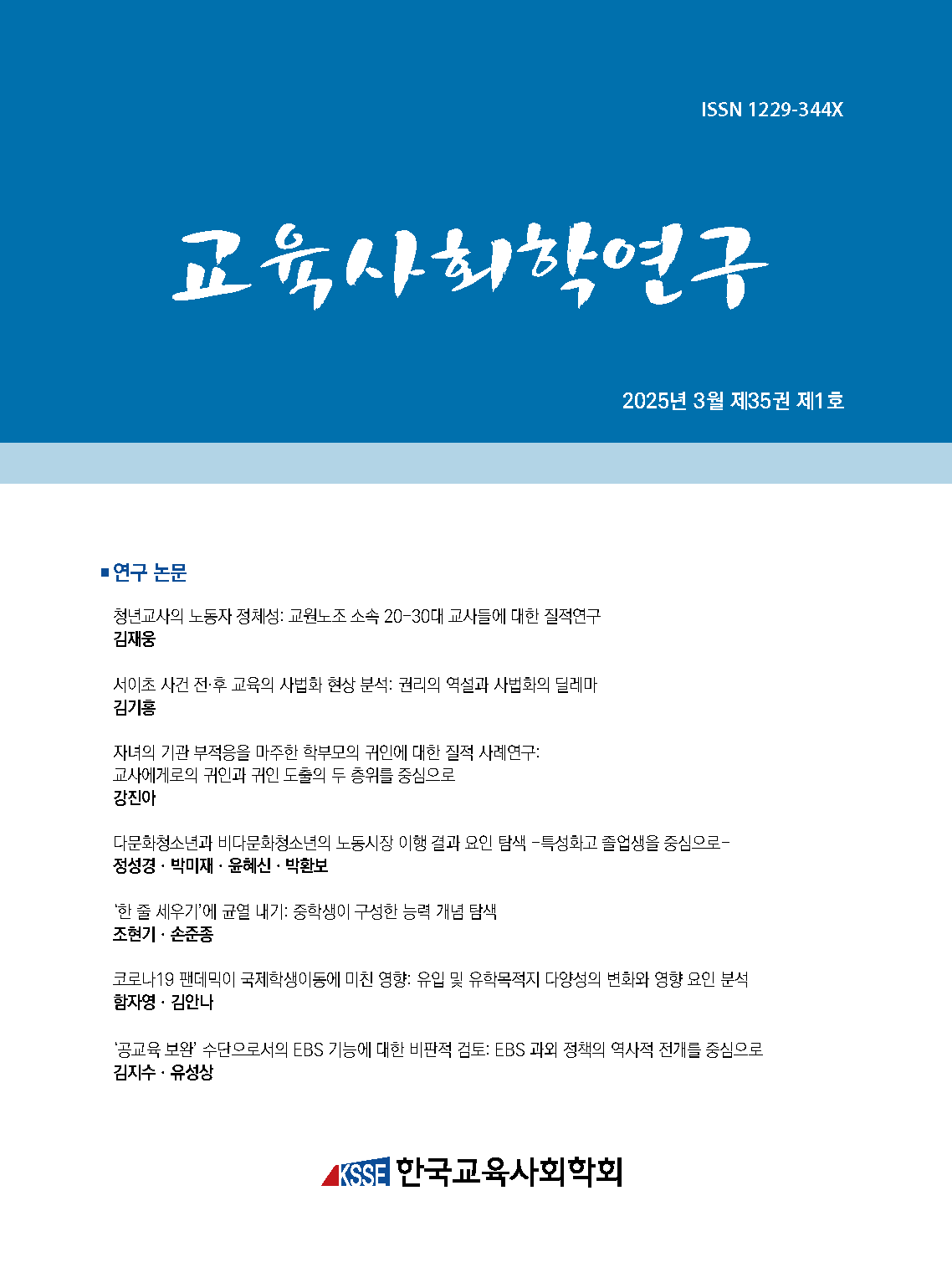학술논문
코로나19 팬데믹이 국제학생이동에 미친 영향: 유입 및 유학목적지 다양성의 변화와 영향 요인 분석
이용수 90
- 영문명
- The Impact of the COVID-19 Pandemic on International Student Mobility: Changes in Inbound and Outbound Diversity and Influencing Factor
- 발행기관
- 한국교육사회학회
- 저자명
- 함자영 김안나
- 간행물 정보
- 『교육사회학연구』제35권 제1호, 177~201쪽, 전체 25쪽
- 주제분류
- 사회과학 > 교육학
- 파일형태
- 발행일자
- 2025.03.31
5,800원
구매일시로부터 72시간 이내에 다운로드 가능합니다.
이 학술논문 정보는 (주)교보문고와 각 발행기관 사이에 저작물 이용 계약이 체결된 것으로, 교보문고를 통해 제공되고 있습니다.

국문 초록
코로나19 팬데믹은 세계 고등교육과 국제학생이동에 중대한 변화를 가져왔다. 본 연구 코로나19 팬데믹 기간 국제학생이동의 변화를 실증적으로 분석하고, 유입 및 유학목적지 다양성의 변화와 그 영향 요인을 규명하고자 하였다. 이를 위해 2019~2022년 UNESCO 데이 터를 활용하여 유입 국가 수(Inbound Diversity)와 유학목적지 국가 수(Outbound Destination Diversity)를 종속변인으로 한 위계적 회귀분석(hierarchical regression analysis)을 수행하였다. 분석 결과, 유입 국가 수는 2019년에 고등교육 경쟁력과 디지털 인프라가, 2020년에는 ‘긴급의료투자’와 ‘소득지원’이 유의미한 영향을 미쳤다. 2021년에도 ‘긴급의료투자’가 지속적으로 영향을 미쳤으나, 경제적 지원 정책의 효과는 감소하고 전통적인 요인이 다시 주요 변인으로 자리 잡았다. 유학목적지 다양성은 2019년에는 고등교육 경쟁력과 디지털 인프라, 2020년에는 ‘학교폐쇄’가 유학목적지 다양성을 증가시키는 요인으로 나타났다. 2021년에는 ‘긴급의료투자’와 ‘백신접종지원’이 유의미한 영향을 미쳤다. 전반적으로 코로나19 팬데믹 기간동안 일부 요인의 변화가 관찰되었으나, 2021년 이후 고등교육 경쟁력과 디지털 인프라가 다시 주요 영향 요인으로 작용하며 기존 유학 중심국의 우위가 유지되었다. 이는 코로나19 팬데믹이 단기적으로 이동 경로에 변화를 초래했으나, 장기적 다변화로 이어지기 위해서는 국가별 교육 경쟁력과 정책적 대응이 중요한 요인으로 작용할 수 있음을 시사한다.
영문 초록
The COVID-19 pandemic has significantly reshaped global higher education and international student mobility. This study empirically examines shifts in inbound and outbound destination diversity before and after the pandemic, identifying their key influencing factors. Using UNESCO data from 2019 to 2022, a hierarchical regression analysis was conducted with inbound country diversity and outbound destination diversity as dependent variables. The findings indicate that in 2019 (pre-pandemic), higher education competitiveness and digital infrastructure were primary factors influencing inbound diversity. In 2020 (early pandemic), emergency medical investment and income support emerged as significant factors, while in 2021 (mid-pandemic), emergency medical investment remained relevant, though the influence of economic support policies declined as traditional factors regained prominence. For outbound destination diversity, higher education competitiveness and digital infrastructure were the main factors in 2019. In 2020, school closures contributed to increased outbound diversity, whereas in 2021, emergency medical investment and vaccine support became significant, underscoring the growing role of public health security in international student decision-making. While temporary shifts in mobility determinants were observed during the pandemic, from 2021 onward, higher education competitiveness and digital infrastructure re-emerged as dominant factors, reinforcing the advantage of traditional study destinations. These findings suggest that although the COVID-19 pandemic disrupted mobility patterns in the short term, long-term diversification will depend on national educational competitiveness and policy responses as critical influencing factors.
목차
Ⅰ. 서론
Ⅱ. 이론적 배경
Ⅲ. 분석 방법
Ⅳ. 분석 결과
Ⅴ. 결론 및 제언
키워드
해당간행물 수록 논문
- 자녀의 기관 부적응을 마주한 학부모의 귀인에 대한 질적 사례연구: 교사에게로의 귀인과 귀인 도출의 두 층위를 중심으로
- 청년교사의 노동자 정체성: 교원노조 소속 20-30대 교사들에 대한 질적연구
- 다문화청소년과 비다문화청소년의 노동시장 이행 결과 요인 탐색 -특성화고 졸업생을 중심으로-
- 서이초 사건 전·후 교육의 사법화 현상 분석: 권리의 역설과 사법화의 딜레마
- ‘한 줄 세우기’에 균열 내기: 중학생이 구성한 능력 개념 탐색
- 코로나19 팬데믹이 국제학생이동에 미친 영향: 유입 및 유학목적지 다양성의 변화와 영향 요인 분석
- ‘공교육 보완’ 수단으로서의 EBS 기능에 대한 비판적 검토: EBS 과외 정책의 역사적 전개를 중심으로
참고문헌
관련논문
사회과학 > 교육학분야 BEST
더보기사회과학 > 교육학분야 NEW
- Kingdon의 정책흐름모형을 활용한 수능제도 정책변동 분석
- 중국 대학생의 학습동기와 학업성취감의 관계에서 학업 자기효능감의 매개효과
- 2015, 2022 개정 교육과정의 ‘독일어권 문화’ 비교: 교육과정 문서와 교과서를 중심으로
최근 이용한 논문
교보eBook 첫 방문을 환영 합니다!

신규가입 혜택 지급이 완료 되었습니다.
바로 사용 가능한 교보e캐시 1,000원 (유효기간 7일)
지금 바로 교보eBook의 다양한 콘텐츠를 이용해 보세요!



